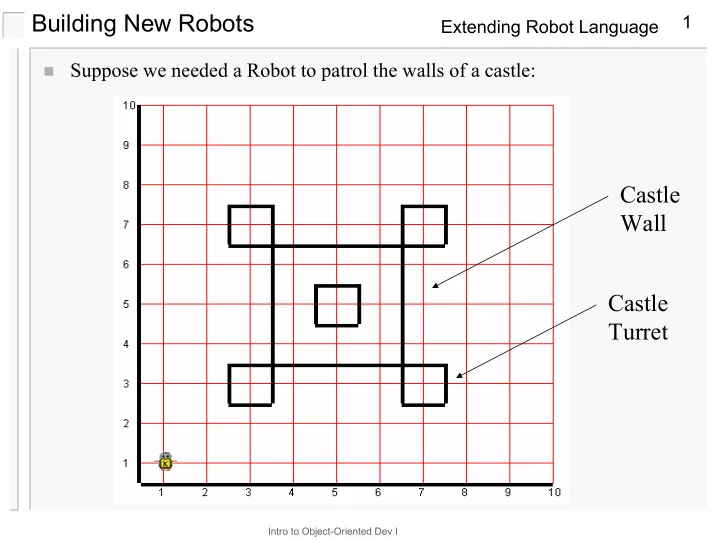

Building New Robots 1 Extending Robot Language � Suppose we needed a Robot to patrol the walls of a castle: Castle Wall Castle Turret Intro to Object-Oriented Dev I
Building a Castle Guard Robot 2 Extending Robot Language � We could solve this problem by writing the solution as we have with our earlier Robot programs � We would find that the code would become very long – Making it harder to read and understand – Making it harder to figure out where our logic errors are � We would also notice that there is a lot of repetitive code � There has to be a way to improve readability, maintenance, and re-use code � Suppose we had a Robot that knew how to patrol the walls of a castle? � We can build one… Intro to Object-Oriented Dev I
Defining New Classes of Robots 3 Extending Robot Language � To build a new class of robots, we include a new class specification in a new file of our program � The general form of this specification: class <new-class-name> extends <old-class-name> { <list-of-new-methods> } old-class-name old-class-name new-class-name new-class-name Intro to Object-Oriented Dev I
Specification Details 4 Extending Robot Language � Reserved Words and symbols – class – extends – braces { } � We must replace the elements in angle brackets < > appropriately what do we call this new type of robot? – <new-class-name> what old robot to add features to? – <old-class-name> list of new features – <list-of-new-methods> Intro to Object-Oriented Dev I
Naming Things 5 Extending Robot Language � In developing the names for robots and new methods – any uppercase and lowercase letters {A..Z, a..z}, digits {0..9}, and underscore { _ } can be used – unique name to the program – does not match any reserved words – must begin with a letter � typically upper case for a class � lower case for a method or instruction Intro to Object-Oriented Dev I
extends Robot? 6 Extending Robot Language class CastleGuard extends VPIRobot � By use of the extends keyword we indicate the CastleGuard inherits all the capabilities of the VPIRobot class in other words CastleGuard knows all about move(), turnLeft(), – pickBeeper(), putBeeper(), and shutOff() � VPIRobot is the base class of CastleGuard VPIRobot VPIRobot � CastleGuard is a derived class of VPIRobot � IS-A relationship – CastleGuard IS A VPIRobot CastleGuard CastleGuard Intro to Object-Oriented Dev I
Class header: CastleGuard 7 Extending Robot Language class CastleGuard extends VPIRobot { } � The CastleGuard robot inherits information and extends the capabilities of the VPIRobot robot Everything a VPIRobot can do, a CastleGuard can do – move(), turnLeft(), pickBeeper(), putBeeper(), turnOff() – But a CastleGuard will be able to do more (have more features) – � FYI: The name of a class will be same as the name of the file that contains it, with a .java suffix The CastleGuard class will be specified in the file CastleGuard.java – Intro to Object-Oriented Dev I
Constructing a new robot 8 Extending Robot Language � The class constructor method: public CastleGuard (int street, int ave, Directions.Directions facing, int numBeepers) { super(street, ave, facing, numBeepers); } � This specifies how a CastleGuard robot is to be initialized � Since a CastleGuard is a VPIRobot it must be initialized in the same way. � We must specify location, direction, and number of beepers – A constructor has the same name as the class – Constructor methods are NOT inherited. – The super keyword indicates that this object is to be built the same way as its parent , VPIRobot – The super keyword invokes the constructor of the base class. – Our robot constructors will always look like this at the beginning Intro to Object-Oriented Dev I
New robot methods 9 Extending Robot Language public void turnRight () { turnLeft(); turnLeft(); turnLeft(); } public is a modifier letting us know that we can access this method from outside � the class (in task(), for example) void is a keyword indicating that the method returns nothing. � Notice that CastleGuard () can use turnRight() as part of its other method � definitions Intro to Object-Oriented Dev I
Advantages of building new robots 10 Extending Robot Language � Structure problem solutions � Programs become easier to understand and read � Lead to fewer errors � Enable future modifications and code reuse � Debugging programs is easier New instructions can be tested independently – New instructions impose structure, which makes it easier to find bugs – Intro to Object-Oriented Dev I
Over-Riding Methods 11 Extending Robot Language � What if we wanted a CastleGuard robot to leave a trail of beepers as it patrolled? � We could do this by adding a new method, but we could also do it making it the default move behavior of CastleGuard robots. � We do this by over-riding the inherited move() method: public void move() { putBeeper(); super.move(); } � By including the above method declaration in our CastleGuard robot class it will replace (over-ride) the default inherited move() method. � Recall that the super keyword allowed us to invoke the inherited base class constructor, it can also be used to invoke the base class over-ridden method. Intro to Object-Oriented Dev I
Recommend
More recommend